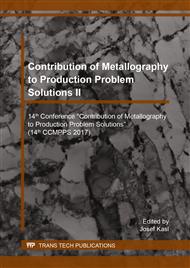p.156
p.162
p.168
p.174
p.183
p.189
p.197
p.205
p.212
Quantitative Evaluation of Secondary Phases in a Weld Joint Made of COST F and FB2 Creep Resistant Steels
Abstract:
Conventional (CCT) and accelerated (ACT) creep tests of a weld joint made of COST F and COST FB2 steels were carried out over a temperature range from 550 °C to 650 °C. Fracturing of the crept specimens was located in the heat affected zone (HAZ) of the F steel. Two specimens were selected after CCT and ACT for quantitative evaluation of the precipitates and compared to the weld joint in as-received conditions. Scanning and transmission electron micrographs were used to measure the precipitate size. Both methods were compared and the accuracy of the results was discussed. It was concluded that ACT can simulate the precipitation of chromium carbides and structure recovery during long term creep exposures. However, precipitation of Laves phase during CCT was not recorded after ACT. Therefore, it is difficult to use ACT in this experiment for estimating the long term creep strength.
Info:
Periodical:
Pages:
183-188
Citation:
Online since:
November 2017
Authors:
Price:
Сopyright:
© 2017 Trans Tech Publications Ltd. All Rights Reserved
Share:
Citation:


